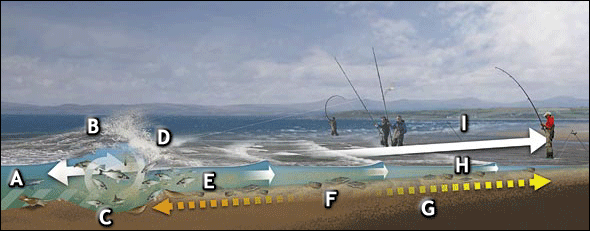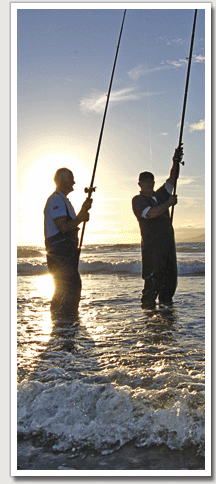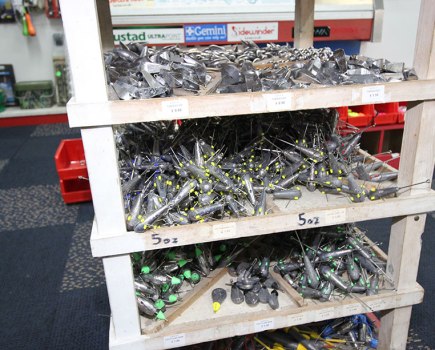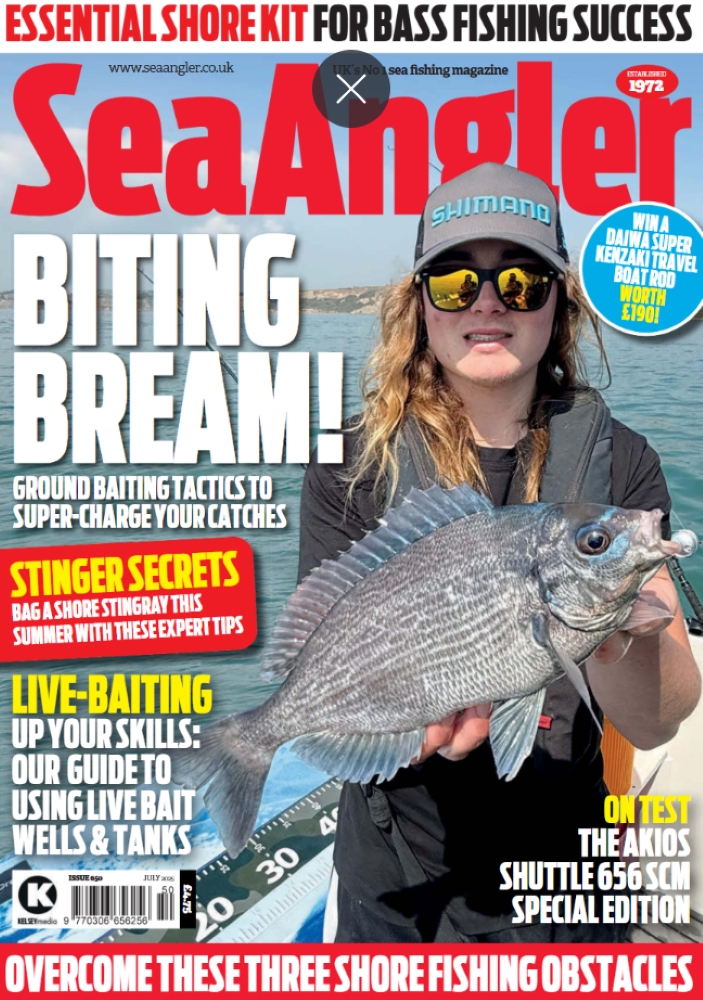Few sea angling venues can better the surf beach for atmosphere and heart-thumping angling excitement, with the noise of the pounding waves stimulating the basic angling instinct. But what’s going on underwater and where are the bass feeding?
Surf is synonymous with bass, and most anglers are in agreement that fishing for this exciting and sporting species really takes some beating.
The tactic spawned a cult following and even today a complete range of tackle is produced with surf bass in mind. However, there are many other species found on surf beaches and these vary from venue to venue. Basic fishing tactics are similar in that most of the fish are found inside the surf line and often very close to the shore.
Surf fishing is not for the static angler loaded down with tackle who wants to camp as well as fish. Surf is ever on the move, and therein lies the secret of fishing in it. Some of the best known surf beaches stretch for miles of seemingly endless and featureless sand and surf, although some days the surf dies away, leaving the surface of the sea like glass. Given an onshore wind the sea comes alive as the surf stirs the sea bed, threatening the marine habitat – and that’s the only reason the bass and other opportunist feeders are there.
Water clarity on many surf beaches is influenced by the sand, sediment and silt content of the sea bed and surrounding shoreline. This dictates species in lots of cases. Many of the most famous and productive surf bass beaches have clear water even when the surf is raging, and this happens because the heavy sand sinks to the sea bed rather than clouding the water, which is what occurs when you get the same conditions around large silty estuaries.
In our illustration (page 74) we show the typical surf beach through rose tinted glasses because fish location over miles of surf is still important and not all white water will contain fish. Wind and tide play their part because food disturbed by a large surf may not always be pushed inshore. It often travels along the surf line and creates hot spots in any deeper holes and gullies it settles in.
Many surf anglers suggest it is possible to read the surf and, in many parts of the world, brown water in heavy surf is targeted. In the UK it is important to give your choice of fishing spot some thought – the best fishing is not always in front of your parked car.
HOW TO LOCATE THE FEEDING FISH
Remember that the main fish action is where the surf gouges out the sand
Species distribution in surf is fairly standard. You will find flounders everywhere, particularly in the flat sections (flats) between the wavelets and inside the surf. During the flooding tide flounders sometimes have their noses against the edge of the trickle that floods the sand.
However, the main fish action is always where the surf gouges out the sand, with the overspill of sand and food particles stretching inwards through the wave flats. The third flat from the beach towards the main breaker is the hot spot on a majority of surf beaches.
Beyond the surf the deeper undisturbed water is home to rays, dogfish and the other deeper water species, but from many surf beaches clearing the surf is near impossible because of the distance involved. It’s then that accurate casting comes into play, and because the surf line is always moving keeping your bait in the hot zone of action is very important.
One of the most surprising things that novice anglers find out about a surf beach is the close proximity of some of the species of fish. It is possible to catch bass (quite often big ones), flounders, turbot, dabs, mullet, coalfish and other species with your leader knot in the tip ring, and that is a good reason to fish lighter without a shockleader on a flooding surf beach because power casting is often unnecessary.
In fact a great tactic is to pull your tackle closer as you walk back with a flooding tide because the fish are ever moving in to examine the sand that has been exposed at low water. Some days they will find food exposed or left by a storm, on occasions even the discarded bait of anglers, and that is a good reason to change your bait regularly and leave a trail for the fish that ends at your hook. The longer you leave your tackle in the sea the further out in the surf it gets and this is not always the best tactic, although it is a useful option on some venues.
Alarge bait or baits cast at low tide and then left as the angler walks back with the sea, letting out line as he goes, is a favourite tactic from some of the estuary surf beaches like those in the Bristol Channel, and is also worth considering when it is calm. On most days, keeping your baits in the active part of the surf as it moves is the deadliest tactic.

A: Other species lurk outside the wave disturbance. B: Bass look for food in the surf. C: Low tide lip. D: Wave action dislodges food and spews it inshore. E: The main flatfish action is at the third wave flat. F: Flatfish feeding inside the third wave flat. G: Fish are moving continually on the flood and ebb tides. H: Flatfish will nose the edge of the wavelets. I: You can hold your rod or use a tripod
LEAD WEIGHTS KNOW-HOW
Useful advice on when to use a plain or wired sinker
Powerful surf can drag lines and tackle along the shore, so a wired grip lead is essential if you want to offer a static bait.
There are also several odd-shaped plain lead weights that will stay put in surf, notably the pyramid and the old-fashioned watch shape.
Awired lead weight cast into the main breaker may be buried and difficult to retrieve and so it is important to use the best lead style for the conditions.
Two grip wires in a breakout lead can be better than four sometimes, while the plain bomb, torpedo or pear are favoured in calmer conditions when they can be used to trundle your bait into holes and gullies where food may have collected.
The secret of the surf is putting your bait where the fish are located, using accurate casting and moving the lead weight to find the fish.
BEST BAIT CHOICE
What’s your selection?
Lugworms have the edge for bass, while small ragworms and harbour rag (maddies) take flounders and mullet.
Peeler crabs in their local season can be deadly, although shellfish are favoured on some venues where they are washed inshore in numbers.
Sandeels are not so successful, although a fish tip, such as mackerel, does catch flounders and turbot from many surf marks.
Old lugworms and shellfish also have the edge on occasions.
CHOOSE THE BEST RIGS
Learn to spread your baitfish
Perhaps the best rig is a simple one-up, one-down paternoster. This can be cast at short and medium range, which is often all that is required, and its configuration spaces the two baits as widely apart as possible in a standard casting rig.
Rig length is crucial because the fish are often found in a narrow band in front of the surf and a longer sprawling rig gives the baits more chance of being found by a fish.
Your other options of the same rig include the use of one hook (size 3/0) specifically for bass, or three hooks (size 1 or 2) for fishing for flounders, dabs, turbot, mullet and coalfish.
Adjustable rig stops used to fix hook snood positions allow the snoods to be moved up and down the rig body and are perfect for flapper-style rigs fished in surf. For fishing in or beyond a distant surf line the standard one-up, one-down clipped loop rig streamlines hook baits and offers extra casting range.

STAY MOBILE ALONG THE SURFLINE
Keep gear to a minimum and make sure you have chesties
 Setting up camp is not really possible when fishing the surf, so your tackle needs to be compact, minimal and light so you can keep close to the sea at all times.
Setting up camp is not really possible when fishing the surf, so your tackle needs to be compact, minimal and light so you can keep close to the sea at all times.
Fishing 100 yards back from the wave edges is not ideal, especially when trying to judge casting distance. Chest waders are an essential part of surf fishing, not only because there is no chance of erecting a beach shelter, but also because you are always on the move. Chesties keep you dry and allow you to wade and beach fish without fear of getting a soaking.
Most anglers also prefer a tackle box, not least because it keeps gear dry even if floated by those rogue surf surges. Aclip-on side tray saves the need to place bait on the sand where it is likely to get washed away.
Atripod is handy if it incorporates a butt cup and head that allows the rod tip to be raised above the wave movement which, even when fishing close, can produce lots of false bites. Aclip-on bait tray under the tripod holds items you need at hand when fishing the surf. If you like holding your fishing rod, a simple monopod stand will suffice while you are baiting up.
THE WONDER OF WADING
But never be tempted to wade out too far!
There is a natural instinct to wade into surf, especially when fishing for bass, because standing holding your rod in the tumbling water is exciting.
On many venues the surf line is distant, particularly during a big sea, and a few extra yards gained to reach the surf hot spot can be invaluable. However, around the UK the surf beaches have several species that are found almost under the angler’s feet and these include flounders, mullet, turbot and sometimes even the bass.
So wade if you wish, but remember that you may wade past the fish and it may be unwise to go too far or in front of anglers casting in case of a snap-off.
LURE FISHING IN SURF
Remember it’s mainly a tactic for schoolies
Fly-fishing, spinning and plugging for bass are all possible from some surf beaches. However, the conditions for this type of angling are not always ideal and fishing with bait is sometimes the only option.
If you want an angling challenge then fishing a lure is just that, but don’t expect record-breakers because the tactic catches mainly schoolies from the shore; big bass are best fished for with a big juicy bait.
You may also like
Lure fishing for Bass: Cracking the code to watercraft
HEAR THE CALL OF THE IRISH SURF
Ireland sets the standard with a close season and a bag limit
We could not finish without talking about the Irish surf beaches.
They epitomise what surf bass fishing is about, having had a cult following from the 1950s to 70s when surf bass fishing became the specialised branch of sea angling it is today.
The Irish have also moved to protect their bass stocks with a close season and bag limit.
The atmosphere of a raging surf alone is enough to excite even the hardened pessimist roused by the sound of a noisy but lonely surf beach.
It is addictive – beware!

For more sea fishing advice, head to our Tips and Tactics section







